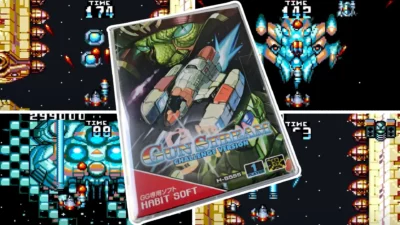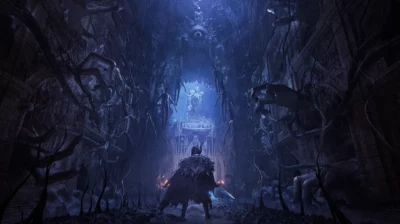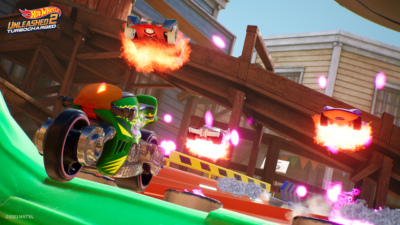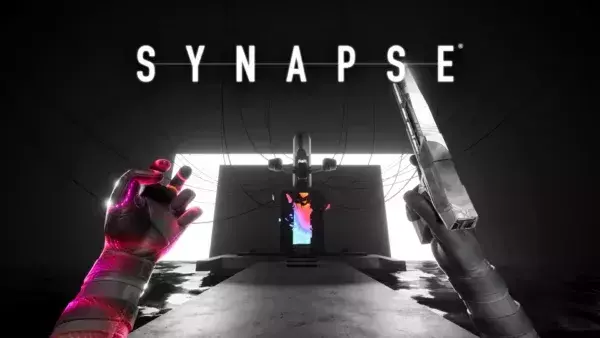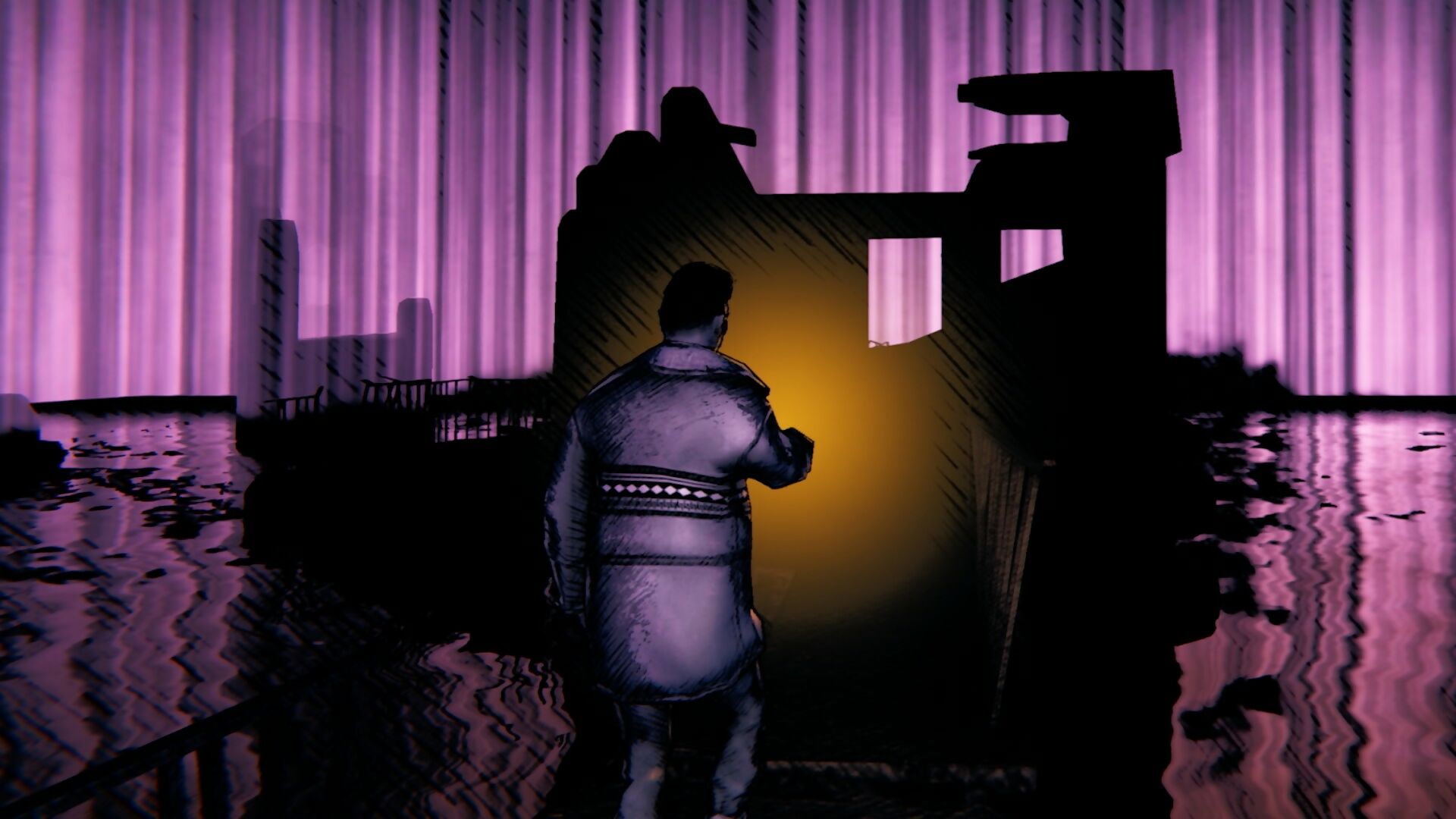
An air of mystery hangs as thick as fog in the village of Gravoi. Its maze-like streets change configuration each time you play, and there are shadowy figures that vanish when you attempt to follow them. Then there’s the abandoned mine, from which an imposing, rattling creature will soon emerge to stalk and kill you.
Should you get caught by the fiend, the game will switch perspectives to another character, the town will shape-shift into a new layout of narrow streets, and you’ll continue on your quest to discover Gravoi’s secrets: what does the monster have to do with the mine that lies beneath the town? What connections does the game’s cast of outsider characters have to the town and its ancient customs?
As play shifts abruptly from, say, Anita, a geologist investigating the mines, to Paul, a photojournalist who may have captured a rare image of a creature lurking beneath the village’s streets, the effect can be borderline dizzying.
But what keeps you oriented in Saturnalia’s fever dream is its ingenious menu system. It might seem odd to pick out something seemingly dry and functional in such a handsomely crafted game, but the Clues screen is something of a work of art in itself: a node-structured map of characters and items that gives you an at-a-glance guide to everything you’ve encountered so far and the things you have to do next. “I worked with two designers that specialise in infographics to find ways to convey how everything’s interconnected,” says studio director Pietro Righi Riva. “There’s so much to keep track of in the game, and so much of the information about the characters and their backstories is explained through the things you find. So having a way to at least try to connect the dots for you – without excessive exposition or hand-holding – has been so important. We wanted everything that happens in the village to make sense in an interconnected storyline that can be discovered in any order.”
It’s a valuable bit of grounding in a game that, otherwise, leaves you to figure everything out for yourself. From Saturnalia’s opening frames, you’re thrown headlong into Gravoi – a village nestled on the island of Sardinia – and the air of uncertainty and dread builds so subtly that it’s only when you hear the death rattle of a monster behind you that you realise just how disturbing the game is. Certainly, the nightmare vision of Sardinia is far away from the sunlit idyll you might have seen in travel brochures.

You’ll be studying objects for clues a lot in Saturnalia. Don’t worry – the chap on the couch there’s just asleep.
“It’s an island full of beautiful landscapes where people go vacationing,” Righi Riva agrees, when asked why Sardinia was chosen as Saturnalia’s location. “But Sardinia’s also very isolated as a place. Sardinian, as a language, is so dramatically different from Italian that if someone’s speaking to you in Sardinian, there’s no possible way, if you’re Italian, that you’ll understand anything at all. The same goes for many sides of the Sardinian culture: inland, there are these isolated communities that still maintain rituals and culture that have existed for hundreds if not thousands of years.”
One of those rituals – the titular Saturnalia festival, traditionally held each December – also forms the game’s backdrop. As we stumbled about the place, slightly lost but constantly intrigued, something specific came to mind: the 1970s cult horror film, The Wicker Man, also about an isolated island community and its secret, even murderous customs.
“The Wicker Man is definitely one of our most shared influences with the entire team,” Righi Riva says. “Like, it’s a required watch for everyone that’s working on the project. Particularly for its slow build-up. Something’s not quite right, but it’s not right for the reasons you think it is. I love The Wicker Man because the protagonist is this bigoted man who’s judging the people in the village for all the wrong reasons, and ends up in a surprisingly different place from where he expected. We tried to convey this idea that the real horrors in the game lie elsewhere from where you expect at the beginning, in terms of responsibilities and the concept of evil itself.”

The splashes of vibrant cyan and magenta add to the sense of vivid, cinematic horror.
Key to Gavroi’s eeriness is not just the richness of its period detail – the 1980s political posters, which jump out amid the sketchy art style, the sense of age in the stone buildings – but in the way its narrow streets and buildings reconfigure each time play switches to a new character. For Santa Ragione, it’s a response to a typical flaw that game developers have wrestled with for years: once a player dies, how do you keep the sense of horror fresh, and avoid unnecessary repetition? “When you fail at the game, you’re trading how well you’ve learned the village so far,” Righi Riva explains. “Since that’s a big part of the game – understanding your surroundings and how everything’s connected – there’s those stakes. It’s scary because there’s something to lose, but we’re not punishing you by making you repeat something. That’s how we ended up with a procedural village.”
That procedural generation didn’t come without a development cost, however: every permutation of street, building, and staircase has to feel believably like a Mediterranean village, as surreal as the lighting and abrupt dead-ends might make it feel. To make matters more difficult, the mines that run beneath the village are intimately connected with the buildings above, while signs that, say, point the player in the direction of a church, have to change to match the newly generated layout. “The ‘church this way’ sign isn’t pointing in the direction of the church in a straight line,” Righi Riva says. “It’s pointing you towards the roads that lead you to where the church is. And that’s extremely hard to do, because it’s all this dynamic pathfinding we’re doing through the game.”

Like the rest of Gravoi, the mines change layout each time you visit them. It’s pretty eerie down here.
Nor is the map the only thing subject to this randomised approach; the game’s four protagonists can be unlocked and engaged with in any order, and their location in the village will, inevitably, change during each run. This means that the narration itself needs to be procedurally generated, with the correct lines plucked from the script and presented, depending on where the player is in the story and the current context. “It’s especially challenging to test,” Righi Riva tells us, “because you have to play through the game in all its configurations, doing missions in any order with any character, and see if it still makes sense, both from a narrative design standpoint, and also to test the logic is solid enough – whether it can sustain a specific situation and pull out the right lines from the screenplay.”
The random factor extends even to the sound effects: the creature you’ll find stalking you through the streets – which we won’t spoil by describing in detail here – makes a distinctive set of noises that are partly based on a quartet of singers recorded in Sardinia. “I feel like, when you have memorable horror monsters, they all come with their own sound effects,” Righi Riva says. “So we did a lot of research, using recordings and audio archives from traditional Sardinian instruments… you can also hear quarteto tenor singers at different points. We went to the island specifically to record them for the game. There are procedural Sardinian folk songs that are four people riffing off each other to create these melodies and sounds.”

Sound plays a big part in Saturnalia: the creature on your trail is especially sensitive to it, so do try to keep quiet.
Underlining Saturnalia’s rising sense of dread is its captivating art style: a hand-drawn look with monochrome environments and bewitching splashes of eye-popping colour. It’s a style informed by the masters of Italian horror cinema – anyone who’s seen Dario Argento’s demented cult staple Suspiria or the work of director Mario Bava will recognise the game’s dedication to deep shadows and punchy chromatic splashes. At first, we mistakenly assumed that the game’s visuals were cel-shaded – something Righi Riva gently corrects when we ask him about it. “Without getting too technical, when you do cel-shading, you have these distinguishable lines where the light changes intensity over a model,” he says. “We use a custom lighting model where the entire game is in black and white, and all the colour you see is done in post-processing, so it’s painted in based on the context. Every single texture in the game is black and white. Then, for everything that’s animated, we sample everything at twelve frames per second, and then distort the mesh of the characters so that they look like they’re being hand-drawn – they look like rotoscoped, traditional animation.”
Having spent some time with Saturnalia, it’s clearly shaping up to be a unique, absorbing horror experience: entirely lacking in cheap jump scares, it instead draws you in with its believable characters and their everyday travails, before gradually lowering you into a benighted world of strange customs and subterranean terror.

The Clues menu gives you a top-down view of characters, items, and your next objective.
Moment in time
Saturnalia’s late-eighties time period wasn’t chosen for Stranger Things-style nostalgia; rather, it’s both practical – the lack of internet and mobile phones adds to the sense of mystery and isolation – and also political. Although Saturnalia isn’t as overtly about, say, second-wave feminism as Wheels of Aurelia was, there’s still a context waiting to be found if you want to find it, Righi Riva says. “I think, from a political point of view, (the 1980s) is a time that’s recent enough, especially in Italian history, that its problems are also relatable to today’s problems. So we can still talk about characters and their struggles, and their problems with discrimination, with workers’ rights, and it’s still very true today. People can still make the connection when they play the game, and relate to that.”


